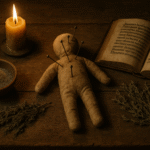
At first glance, Robert the Doll might look like any other weathered antique toy. But for those who know his story, he’s far more than that—he’s a cultural icon, a supernatural legend, and, in many ways, a unique work of art. What makes Robert truly fascinating isn’t the way he was made, but how he was transformed over time by his owners, by legend, and by the eerie atmosphere that surrounds him.
Mass-Produced Beginnings: A Common Toy with an Uncommon Future
Robert the Doll wasn’t born out of an artist’s workshop or made to be a one-of-a-kind creation. He was manufactured by the Steiff Company, known for producing high-quality stuffed animals and dolls, around the early 1900s. In fact, Robert wasn’t even designed to be a child’s plaything; he was meant as a store display mannequin. A simple, 40-inch felt doll, Robert was one of many produced by Steiff, each one practically identical to the others. He was, by all means, a product of industrial mass production.
When he was purchased and gifted to Robert Eugene Otto, a boy living in Key West, Robert was just another toy. But, like any object, its meaning and value began to shift based on how it was treated—and in Robert’s case, that transformation would take on a life of its own.
Personalization: A Toy Becomes More Than a Toy
One of the first major changes that set Robert apart from other dolls was how Eugene treated him. Unlike other toys that get passed around or left behind, Robert the Doll became Eugene’s constant companion. He even dressed the doll in his own childhood sailor suit, instantly giving the mass-produced toy a more personal and human-like identity. This wasn’t just a doll anymore—it was Robert’s alter ego, an extension of himself.
Eugene’s attachment to the doll is often described as intense and strange. He spoke to Robert, treated him like a real person, and even blamed the doll for mischief around the house. Over time, the doll took on a reputation not just within the family but among neighbors and visitors. People started to notice odd things, claiming to hear giggling, see the doll move on its own, or find furniture mysteriously knocked over.
Whether or not these stories are true, they reveal an important point: the way Eugene interacted with Robert transformed him. He wasn’t just a toy anymore; he became an object imbued with character, life, and, eventually, fear. Eugene’s emotional investment in Robert helped push him from being a mass-produced object to something more like an artwork that evolves over time through interaction and perception.
Modifications and the Passage of Time: Wear and Tear as Art
Part of what makes Robert so haunting today is his weathered, worn appearance. His cracked face and faded fabric are testaments to years of use, neglect, and display. These marks of time add to his eerie allure, but they also serve as a reminder that even the most mundane objects can become something unique through the process of aging and modification.
When Eugene passed away and Robert was eventually donated to the Fort East Martello Museum, his story and his appearance had already taken on a life of their own. The once pristine, factory-made doll had been altered not just by physical wear and tear, but by the emotional weight of years of eerie folklore. His haunted reputation made him something closer to a living artifact, where every crack in his face or faded spot on his suit contributed to his mythology.
Art, in many ways, is about transformation—it’s about taking raw materials and imbuing them with meaning, either through craft or interpretation. Robert became a work of art not because of how he was made, but because of how he was treated. Through constant interaction, personalization, and the myths that grew around him, he evolved into something more than the sum of his parts.
The Role of Storytelling: Turning an Object into Art
One of the key factors in Robert’s transformation from toy to artifact is the role of storytelling. Much like the way a famous painting can develop layers of meaning over time through interpretation, Robert the Doll became more than a toy through the stories told about him. Every time someone reported seeing Robert move or hearing strange noises, his legend grew. These stories acted like brushstrokes on a canvas, shaping Robert’s identity and turning him into something more.
Just like art, which often provokes reactions and invites interpretation, Robert’s existence is tied to how people perceive him. He’s become an interactive piece of folklore, where museum-goers and visitors leave offerings or letters asking for his forgiveness, hoping to avoid bad luck. In this way, Robert continues to evolve as a cultural artifact through the stories that people create around him—much like how a work of art lives on in the way it’s interpreted by its audience.
From Mass-Produced to One-of-a-Kind: The Transformation of Objects
Robert’s story highlights a fascinating truth about mass-produced objects: they don’t have to remain ordinary. Whether it’s through physical modification, emotional investment, or storytelling, even the most common items can take on new meaning. Robert’s journey from a factory-made doll to a haunted, revered figure shows us how objects can transcend their original purpose and become unique, living symbols.
In fact, this transformation isn’t limited to haunted dolls. Throughout history, objects have taken on lives of their own based on how they are treated. Take, for example, the Venus de Milo, which started as a statue of the goddess Aphrodite and has now become an iconic symbol of classical beauty, partially because of the way its missing arms have been interpreted over time. The object itself changes because of how people interact with it and the stories they attach to it.
Robert the Doll is no different. He may have started as one doll among many, but his personalization, modification, and the legends that surrounded him transformed him into a one-of-a-kind piece of cultural history.
Conclusion: The Art of Transformation
Robert the Doll’s journey from a simple toy to a legendary haunted figure reveals the art in everyday objects. Through the way Eugene Otto treated him, the modifications he underwent, and the stories that built up around him, Robert was transformed from a mass-produced doll into something that exists in the realm of art. His story reminds us that art isn’t always about what an object is made of, but what meaning we attach to it. The way we interact with the world around us—the toys, tools, and objects in our lives—can turn even the most ordinary things into something extraordinary.
In Robert’s case, the combination of physical wear, emotional connection, and local folklore made him a living piece of art, a testament to the power of transformation through storytelling and human interaction.




